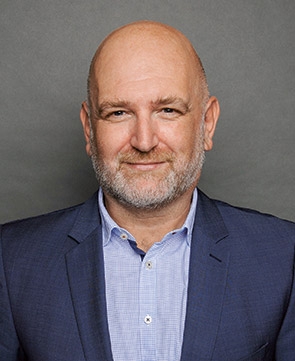For Stefan Schweiger, IoT isn’t first and foremost about the technology, but more about how it can be used. “When it comes to IoT, it’s important to understand the customers’ business and the challenges they face before offering a tried and tested solution.” A digital solution for a general problem, then. Digital data can be worth an enormous amount as companies can leverage it to operate more economically and sustainably and relieve the burden on their employees. But how do we get our hands on this data? Let’s first take a look at the basic principle of IoT.

The basic principle of IoT.
The Internet of Things is essentially about visualising the status of physical objects—from buildings and machinery to fridges and goods in transit. These objects are equipped with sensors that come in all shapes and sizes such as cameras, microphones and thermometers and sensors to record location, torque, humidity, viscosity, etc. These then deliver information on the condition or position of an object to an (edge) gateway device that then transmits the data into the cloud. From there, applications can access this information and utilise it for a wide range of purposes.
For example, Stefan Schweiger and his team developed a complete solution for care homes and hospitals and successfully rolled it out at customers’ sites. The challenge was to regularly check the temperature in medical fridges despite a shortage of workers. The solution? Temperature sensors that transmit every five minutes and automatically report issues. This not only took a load of the staff’s shoulders, but meant that fridge temperatures were consistently documented so they could be viewed at any time on a dashboard. Efficient, practical and extremely helpful. The customer can configure the platform themselves and doesn’t have to worry about monitoring sensors and gateways as it’s all included. It’s also all set up according to the principle of self-service making it fully scalable.
A Confluence of Things.
IoT applications are developing at a rapid pace, not least due to the growing uptake of the cloud and IoT in businesses and the scalability they afford. A globally leading provider of diagnostic systems for clinics, labs and doctors’ surgeries has been running an IoT platform that processes information from 4,000 sensors at one location for three years. Over the next few years, the plan is to increase that number to 12,000 and Bechtle is on hand with its IoT rollout service supporting the maintenance and continuous development of this IoT network as well as the implementation of new use cases.
What’s more, IoT technologies are gaining a foothold on the market with sinking sensor prices combined with developed ecosystems and new transfer technologies driving the growth. For example LoRa or LoRaWAN (Long Range Wide Area Network) allows data to be transmitted across large distances without consuming too much power. This technology is ideal for volume applications such as smart cities, smart retail, logistics and transportation where the number sensors make affordable prices and long-life batteries essential. On the other hand, integrating camera streams or monitoring medical devices requires a greater bandwidth that is delivered through 5G mobile networks.
What’s more, the market has recognised the trend towards IoT trend and is calling for the implementation of digital concepts. Stefan Schweiger’s customers report tenders in which digital strategies deliver the decisive competitive edge or are even a basic requirement. Logistics providers have to demonstrate how their pallets are intelligently networked while mechanical engineers stand out from the crowd if they can deliver digital concepts. Stefan Schweiger is convinced, “Companies that get on board sooner rather than later will dominate the market and everyone else will have to to put the work in or else they’ll be left behind.”

"What you can't measure, you can't manage" - In conversation with Stefan Schweiger.
Stefan Schweiger is a man of business - he has 25 years of experience in mechanical engineering and another ten years in logistics. During this time, he has seen production, warehousing and shipping of many companies from the inside and has continuously trained himself in the field of IT. Since 2016, Stefan Schweiger has been involved with the topics of IoT/AI, Machine Learning, and Blockchain, because: "IoT and AI collect data, Machine Learning delivers insights from it, and Blockchain will take over traceability in the chain, especially in the future." At Bechtle Switzerland, Stefan Schweiger, as Head of IoT/AI Solutions, takes a strategic view that combines the topic of IoT with Bechtle's core strengths.
IoT as a Service.
A service manger would like to introduce remote services so that she doesn’t always have to send people on-site. A logistics manager wants to be able to track his goods and assets. A hospital director doesn’t want his staff to manually read temperatures. Three problems, but all three managers will do the same thing—ask IT. The problem is, the IT department isn’t really familiar with the physical world of sensors and how they interact with the transfer technologies. In many cases, they staff don’t have the expertise to bring everything together in perfect harmony. Then there’s the issue that each application scenario requires its own sensors and the right network technology, data has to be migrated to the cloud and an application with a clear dashboard needs to ensure that everything is easy to view and understand. And that’s not to mention to the security concerns and the organisational challenge of scaling these kind of systems.
But this is exactly where Stefan Schweiger and his IoT team come in—and they aren’t alone. Bechtle has invested considerably in expanding its IoT expertise and is able to deliver everything from sensors to data integration—and the portfolio continues to grow.
Stefan Schweiger is therefore staring the future confidently in the face. Not only does he have the industry experts to advise customers on all things IoT/AI, but his IT system house also offers everything else that is required to leverage IoT to tackle a range of challenges. “We have technical expertise in the fields of sensors, connectivity and gateways to connect to the cloud and generate data. Thanks to Bechtle Analytics we are proficient in business intelligence (BI) and data science, while the specialists at Aproda and MODUS Consult are focussed on Microsoft and ERP systems. Our subsidiary, dataformers, develops customer-specific IoT applications and our Cloud Service Factory is expanding its portfolio to include IoT.”
In addition, there are the important and strong technology partnerships with, for example, Microsoft, SAP, G2K, Iconics, Infsoft and Lufthansa Industry Solutions, but also with innovative start-ups. “Bechtle is the conductor of manufacturers and providers,” Stefan Schweiger says explaining his role, “and that allows our customers to focus on their own strengths.” Particularly when it comes to large projects, companies need a provider that can offer extensive support during the roll out phase, but Bechtle is also on hand during ongoing operations with its network and security, professional and managed services experts handing everything—right down to changing batteries. This gives the customer exactly what they really need—IoT as a Service and thus the data they need to make their business more profitable and sustainable.
 Companies active in the food trade are facing innumerable challenges, but digitalisation can help save costs and free up employees, particularly when it comes to rolling out innovative and fully developed solutions. Fifty per cent of supermarket energy bills, for example, are for cooling. Ten per cent of goods have to be returned due to quality issues and to avoid this, fridges and freezers are often set to be colder than is needed, which leads to a significant increase in energy consumption. On top of this comes the manual work of employees having to monitor the temperatures. With the IoT concept of core temperature measuring, supermarkets can significantly reduce costs for cooling and centralised digital temperature controls. Here’s how:
Companies active in the food trade are facing innumerable challenges, but digitalisation can help save costs and free up employees, particularly when it comes to rolling out innovative and fully developed solutions. Fifty per cent of supermarket energy bills, for example, are for cooling. Ten per cent of goods have to be returned due to quality issues and to avoid this, fridges and freezers are often set to be colder than is needed, which leads to a significant increase in energy consumption. On top of this comes the manual work of employees having to monitor the temperatures. With the IoT concept of core temperature measuring, supermarkets can significantly reduce costs for cooling and centralised digital temperature controls. Here’s how:
- Special sensors measure the air temperature inside the fridges to provide a basis for determining the actual core temperature of the goods inside.
- This is made possible by creating algorithms for each product group, training them and adding them to an IoT platform.
- A core temperature can then be calculated using a profile for each product group and the temperature measured, a method that is as reliable as using a temperature probe.
- Cooling temperatures can be optimally controlled and help reduce energy consumption and costs, plus authorities can track these regulated temperatures at any time.
- Bechtle can support even deeper integration through its close collaboration with its partners such as SAP and G2K that allows the core temperatures to be linked to the parent IoT/AI platforms which themselves are connected via interfaces to the ERP system. The result is that IoT/AI automatically triggers business processes in ERP and helps further optimise workflow efficiency.
Less food waste with IoT: Use Case Alnatura.